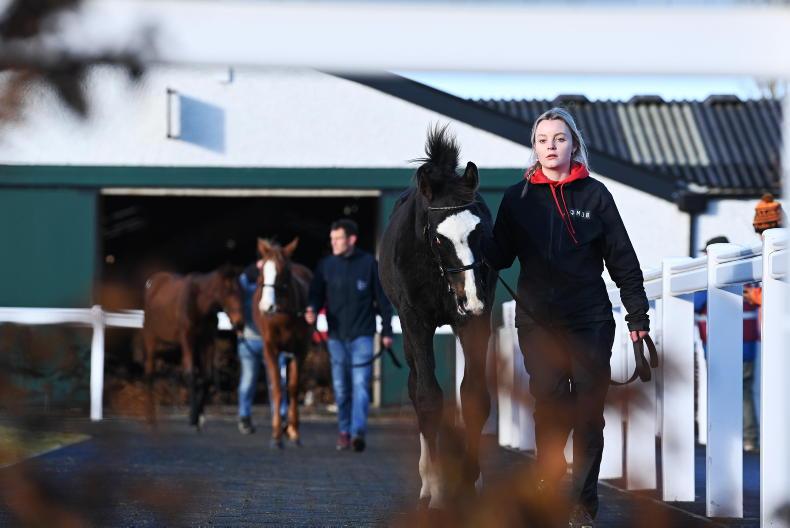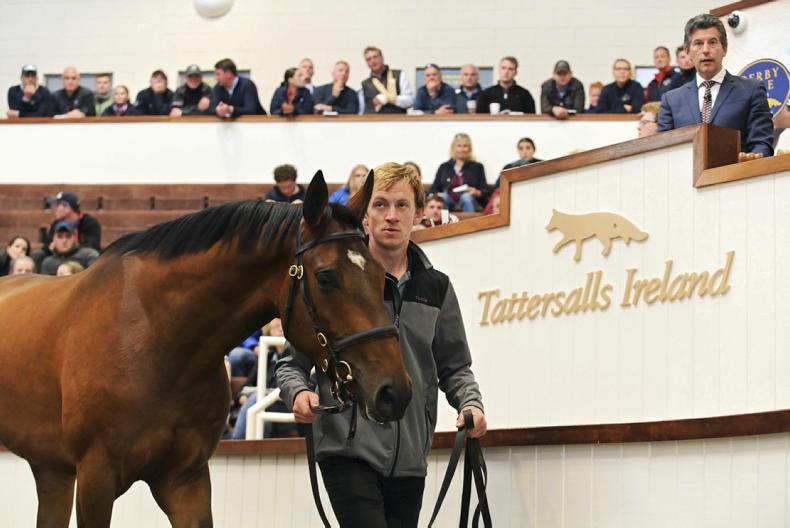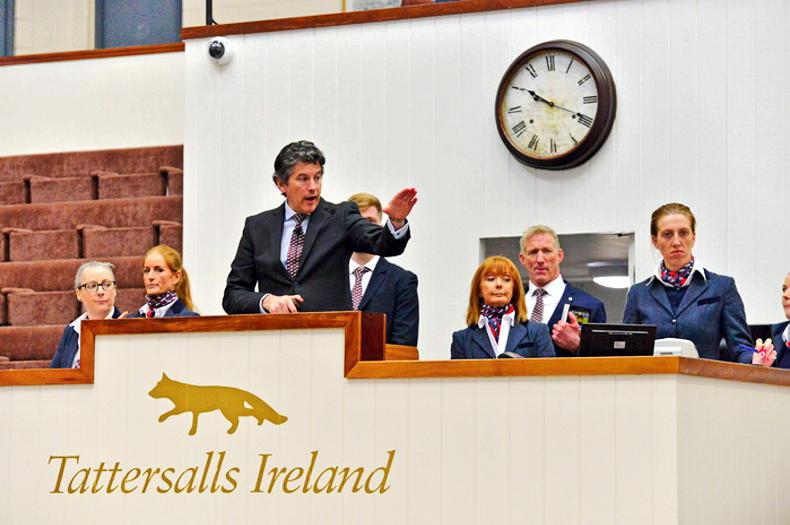Mark Costello: Two of the most impressive winners at the Dublin Racing Festival – Kopek Des Bordes and Ballyburn – are graduates of the Tattersalls Ireland Derby Sale. A good start to the year?
Simon Kerins: I know it’s a cliche, but our graduates winning is our biggest marketing tool. We can talk about record prices but when sale graduates win like that, at a meeting like that, it’s a real shot in the arm, and people take notice of it as well.
We sponsored the Grade 1 race won by Kopek Des Bordes. I actually saw that horse as a store when he was with Walter Connors. I go down to Dungarvan to see his horses every year and he’s always got an incredible bunch of stores. He’s a great supporter of Tattersalls.
Kopek Des Bordes is a French-bred, imported by Walter and sold at the Derby Sale. Does Tattersalls Ireland get criticism from Irish breeders about the increasing number of French-bred horses in the sale?
Yes, we do. My argument is that Ireland is a small open economy that trades with the rest of the world. We just can’t put up barriers.
We take what horses we get. We’re not slaves to the market, but we’re dictated by what the market wants, the market requirements. And we adhere to that.
You could say we’re victims of fashion, insofar as whatever is popular will dictate what we offer the market. And French-breds are popular with buyers.
The Irish Field recently published analysis that proved the French-breds were no more successful than the Irish or British-breds, so that’s a lesson in itself.
This year you are introducing, or reintroducing, a two-year-old section to the Derby Sale. How will that work?
The suggestion at the moment is we will have a select session of approximately 20 two-year-old, probably at the end of day one.
Will they all be French-breds?
You know, it’s something we may have to live with. We don’t show prejudice from one breed over another, but we do know generally what the market wants. As I say, sometimes you don’t agree with what the market is saying, but you have to adhere to it.
You have just completed four years as CEO. What have been the most significant milestones or achievements during that time?
It has been as rewarding as it has been challenging. And there have been some very challenging times.
I came into the job towards the end of Covid and we’ve had a number of changes in personnel.
Our flat sales have been really, really good. The September Yearling Sale has held its own, if not progressed.
We’ve really improved the facilities here as well. We’ve spent a lot of money on the entrance, the barn floors, showing areas, parade brings and grooms’ canteen.
In my role as CEO. I suppose I have a greater understanding now of people, and what they’re looking for in terms of job satisfaction and what motivates them.
I’ve always been fascinated by the psychology of people. I work in a collaborative way and a reasonable way. I try and reason with people, but we can’t always give staff or clients what they want.
The National Hunt side of the business is under pressure. Is that fair to say?
I think breeders are facing the same challenges as any other business. Rising costs. We’re all being affected by them. Our operating costs, hay, straws, labour, catering, postage, pedigrees, vehicles, fuel, all of those costs are enormous.
But as a sales company, we haven’t changed our commission in around 24 years. Our entry fees are the only medium where we can increase our income. And there’s an elasticity with entry fees – you can raise it to a level that puts people off and you do get negative feedback.
Going back to your original question, there is a definite polarisation of the National Hunt market at the moment. The top end is very, very strong, but the rest of the market can be challenging, and it’s really selective.
One of the trends I’ve noticed in recent years is that there is no demand for horses that don’t meet market requirements. Years ago they could be sold somewhere but now nobody wants them.
It’s beholden of sales companies and other stakeholders to improve things. We need to attract more people into the National Hunt industry. The flat business is international. National Hunt isn’t.
Breeding and rearing horses for the sales is a very tough game. Are you aware of veteran clients whose children are not interested in taking over the business?
I hear that a lot but there’s nothing that’s easy in this world. You could be working in the Civil Service and be very unhappy in your role.
I think if you have a genuine passion for racing and the bloodstock industry, it can be hugely rewarding to work in it. I’m thinking of people like Barry Kennedy and Anna Murphy, winners of the ITBA Next Generation Award last month. There’s a lot of people like that. Young breeders and pinhookers. That’s a great sign.
So, yes, people these days value their free time more but I would say this industry can be rewarding in a way that you won’t get working in a 9-to-5 job.

"We need to attract more people into the National Hunt industry. The flat business is international. National Hunt isn't." \ Healy Racing
What advice would you give to a young person who wants to start a career in bloodstock? Where are the best opportunities to make a living?
I would say align yourself with people that have done well in the industry. A lot of the most successful people in racing and bloodstock started with nothing, or their parents started with nothing.
Work hard, get experience, travel, listen, immerse yourself in the industry. Find your niche. If you have a critical mass of horses your chances of surviving are better than those with smaller numbers. Spread the risk.
What are your priorities for 2025?
We’re constantly trying to broaden the appeal of our sales and to convince vendors to send horses our way because we can get the buyers here, with support from Irish Thoroughbred Marketing, and give them a good experience. Our breeze-up sale has proven that.
It had the highest clearance rate of any breeze-up in Europe, and pretty much all the key indicators were up. It was extraordinary. And then you see all the UK buyers who came, the Europeans, the Middle Eastern buyers. By all accounts, it’s going to be a very, very strong sale again this year, God willing.
The September Yearling Sale has grown a lot but I feel further growth is possible. So we need a strong catalogue there that we can stand behind and promote around the world.
It has operated in a certain segment in the market, but I feel it can progress even further.
Would you accept that the €250,000 Tattersalls Ireland Super Auction Sale Stakes, confined to graduates of the September sale, has not been a great advertisement for the sale in recent years?
Recently the race hasn’t been a great reflection of the sale. But, historically, the better graduates from the sale didn’t run in it - they ran in the Group 1 races in the autumn.
I think it’s a good thing that the race is part of Irish Champions Festival. It gives buyers at all levels an opportunity to have a runner at a prestigious meeting.
After Brexit and Covid, fewer British runners were coming for a few years. Last year it rebounded, and we hope it’ll be the same this year. But we’re constantly looking at it and tinkering with it and reevaluating it.
It is the longest-running sales race of its kind in Europe. It has stood the test of time. It still holds appeal and the addition of a vendor prize, the two-box Overlander, has proved attractive.

"We get absolutely beautiful horses at the Derby Sale, and I think the vendors get really, really well rewarded." \ Healy Racing
Is it true that Brexit had a benefit for Tattersalls Ireland because it is now cheaper for Europeans to buy at Fairyhouse rather than in England?
We’ve seen a huge increase in European buyers in the last number of years, and that trend is continuing. ITM has been really helpful in that regard and I think people like coming here. We’re also getting more Middle Eastern buyers with deep pockets.
Do you have problems finding hotel rooms here for overseas buyers?
Thankfully, there’s more and more hotels around although some of them are closed to the public. We use the Pillo in Ashbourne, Dunboyne Castle and Carton House.
There’s a few more in the area, and it’s expensive, but the visitors often like to be in the same hotels where there’s great fun.
Would you consider building your own hotel on the grounds here?
I think that was considered before my time here. We’ve had no one knocking on the door and we’d be open to anyone having a chat with us about it. We have just over 200 acres here.
Are you looking at making any changes to the sales calendar?
We’re not looking at adding more sales.
Last year we had the Andy & Gemma Brown Dispersal, which happened overnight, and we added a point-to-point section to our May Sale, because we listened to the market and a number of the point-to-point handlers said they’d like to have a sale in Ireland.
This year the May Sale is purely for horses in training and pointers. We moved the store sale part into the back of the Derby Sale.
We’ve also moved the Sapphire Sale to a stand-alone date in December. Flat breeding stock is one segment of the market we don’t have at all, so we’d like to give vendors an option to sell with us.
You mentioned there have been a lot of personnel changes here in recent years. Could you discuss some of those?
Roger Casey (Finance Director) moved to Horse Racing Ireland in 2022, as did Richard Pugh (Director of Horses in Training) last year.
Paul Gilsenan is our new head of Finance and we also recruited Eamonn McEvoy as Bloodstock Director from Naas Racecourse.
Richard is a great asset to the industry and losing him was a bit of a shock. But Eamonn has been a real positive. I knew him from both Naas Racecourse and his time at Grangecon Stud. He’s a sound, considered, intelligent and fair-minded person.
Tom Rudd returned to us from Limerick Racecourse, and there’s Luke Coen, Robbie Power, Jamie Codd, Barry O’Neill, Timmy Hillman and Alastair Pim. We’ve a really good team on the road.
They’re all male. Tattersalls in Newmarket recently appointed its first female auctioneer. Will we see that here?
I don’t really consider gender when it comes to promoting. But I have promoted two women to being heads of department – Mary Lanigan in marketing and Orla McKenna in bloodstock.
I brought Tammy O’Brien onto the board, the first female to be appointed, not that she would ever shout about that. Those appointments were all made because they were the best people for those roles.
On the subject of auctioneers, the situation in Ireland is that you have to be licensed by the Property Services Regulatory Authority. You need that qualification. I was granted mine retrospectively because I had at least five years’ experience. So it’s very hard for young men and women to break into it.
Where did you get your hands-on experience with horses?
I show jumped and hunted as a kid, I had a background in horses. I’m a nephew of Kevin and the late Paddy Prendergast. I worked in Goffs. I began looking at yearlings with Robert Griffin and Nick Nugent. That’s where I got my experience.
I’d say judging a horse is the easy part. The challenging part is managing the owner’s expectations in the kitchen afterwards! Sometimes people only see things from their perspective. But at the end of the day we’re trying to select the horses that will make the most money for everyone.
What does the selection process involve? Is pedigree more important than the physical?
All the pedigrees are graded for select sales before we go out. We factor in the foal price, the sire, dam, the ratings achieved by the siblings. Sometimes the sire might become hugely commercial, and then that would upgrade the pedigree.
Then we look at the horse and hopefully it matches up with the pedigree. Both elements are hugely important.
What if the pedigree is weak but it’s an exceptional physical?
That’s a nuance you have to work with and you need to use your discretion to make a call.
There are times when I’ve put a horse into a sale based on it being a beautiful physical and it hasn’t sold. It may have ended up being a very good racehorse but it didn’t make the price the vendor expected.
We’re humans. We get it wrong sometimes but we have a general understanding of the market and have the experience.
The Derby Sale turnover has been declining in recent years. What can you do to turn that around?
There have been some fluctuations, but it is a very small catalogue. There’s in or around 400 horses. It was 500 at one time. We had the top store horse price last year and more horses making over 100 grand than any other sale.
I’m not worried about it. We believe in the Derby Sale, as do the vendors and buyers.
We still get absolutely beautiful horses here, and I think the vendors get really, really well rewarded.
We compete strongly for store horses with our competitors.
Do point-to-point handlers enjoy preferable credit terms? If so, is it because they are buying for re-sale, whereas trainers need to find end-users?
I hear this perception about credit terms all the time. As long as I’m in the business, we’ve worked with people who need a little bit more time. We’re not a bank. We pay vendors after 35 days. My wife, who’s an accountant, would say our business model is ridiculous. Why aren’t buyers paying within 35 days?
When it comes to credit terms, it depends on the individual. You have to make a call on people’s ability to pay. We’ve a credit committee here. We’ve a strong board here that looks at the client list and says who we can and can’t give credit to.
By and large we get it right.
But every so often a client who has been paying on time for years suddenly lets you down. The sales company carries that debt.
Over the years we’ve worked with trainers who needed time because an owner might have let them down. We’ve worked with the foal buyer who has yearlings to sell.
The majority of our sales now, September aside, are dominated by people who are buying to sell.
Go back 12 or 13 years and the main buyers at the Derby Sale were end-users. Now it’s guys pinhooking. When they’re buying, they’re selling.
So, we work with everyone. But we charge interest per month because it’s a huge risk we take.
Do many bad payers end up in court?
You want to work with people. You get young people coming in. They’ll put down their own money and look for some credit. You make a call on them. They buy, they sell, hopefully they do well. That’s how some of today’s industry leaders got started. Others are less fortunate and leave the business, but come back again. They are a force of nature!
How would you describe relations between Tattersalls Ireland and Goffs?
They could be better. I think it’s unfortunate that there’s been so many clashes over dates.
I believe there’s a desire among all of us – Edmund [Mahony, Tattersalls chairman], Henry [Beeby, Goffs CEO] and myself - to move forward and work together for the betterment of the industry.
The converse of that is that the clients benefit from such a competitive environment. They can, and do, leverage us off against each other.

Have you any ambitions to become chairman of Tattersalls should the current chairman retire?
I haven’t given it much thought. Newmarket is a big beast and they have a lot of shareholders. It would be like going from the League of Ireland to the Premier League. It’s a big organisation and I expect the challenges would be magnified because everyone who buys and sells there sees themselves as a stakeholder.
Finally, what part of the job gives you the most satisfaction?
The personal connections. There is a buzz from selling big lots and seeing people rewarded, but the best part of my job is making some real, genuine connections with people that you feel good about meeting. Sometimes you’re enriched just by meeting really good people.
Business is business but for me the interpersonal relationships are more important than the money. As I’ve got older I’ve realised success for me is not defined by status. It’s about the type of person you are.
